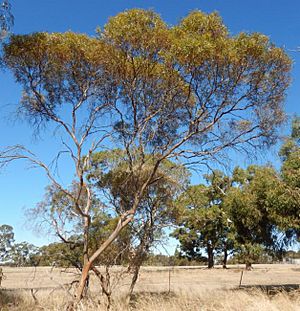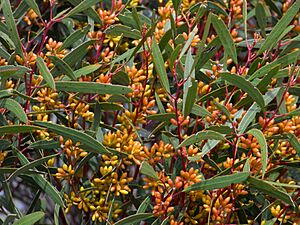March mallee facts for kids
Quick facts for kids March mallee |
|
|---|---|
 |
|
| Eucalyptus leptophylla near Keith, South Australia | |
| Scientific classification | |
| Genus: |
Eucalyptus
|
| Species: |
leptophylla
|
The March mallee, also known as the slender-leaved red mallee or narrow-leaved red mallee, is a special type of mallee tree that grows only in inland Australia. It has smooth, greyish bark and long, narrow leaves. When it blooms, it has groups of seven to thirteen creamy white flowers. Its fruit looks like a small cup or barrel.
Contents
What the March Mallee Looks Like
The Eucalyptus leptophylla is a type of mallee, which means it's a small, bushy tree with many stems growing from the ground. It usually grows to be about 2 to 6 meters (6 to 20 feet) tall. This plant also has a special woody swelling at its base called a lignotuber. This helps it regrow after fires.
Its bark is smooth and can be grey, cream, or even a coppery color. It peels off in short ribbons or long strips. Younger plants and new shoots have leaves that are usually opposite each other. These leaves are oblong or lance-shaped, about 1.5 to 6 centimeters (0.6 to 2.4 inches) long and 0.5 to 2.5 centimeters (0.2 to 1 inch) wide.
The adult leaves grow one after another along the stem. They are shiny green on both sides and can be linear, narrow lance-shaped, oblong, or slightly curved. These leaves are about 3 to 9 centimeters (1.2 to 3.5 inches) long and 0.3 to 1.3 centimeters (0.1 to 0.5 inches) wide. Each leaf has a small stalk, called a petiole, about 0.4 to 1.3 centimeters (0.16 to 0.5 inches) long.
The flowers grow in groups of seven to thirteen in the leaf corners. Each group sits on a cylindrical stalk called a peduncle, which is about 0.3 to 1 centimeter (0.1 to 0.4 inches) long. The individual flower buds are on tiny stalks called pedicels, up to 0.4 centimeters (0.16 inches) long.
Mature buds are oval to spindle-shaped, about 0.4 to 0.7 centimeters (0.16 to 0.28 inches) long and 0.3 centimeters (0.12 inches) wide. They have a cone-shaped cap called an operculum, which is about 0.2 to 0.4 centimeters (0.08 to 0.16 inches) long. The March mallee usually flowers between November and March. After flowering, it produces woody, cup-shaped, barrel-shaped, or half-sphere-shaped fruits called capsules, which are about 0.3 to 0.6 centimeters (0.12 to 0.24 inches) long.
How the March Mallee Got Its Name
The Eucalyptus leptophylla was first officially described in 1856. A botanist named Friedrich Anton Wilhelm Miquel wrote about it based on notes from another botanist, Ferdinand von Mueller. The description was published in a science journal.
The second part of its scientific name, leptophylla, comes from two ancient Greek words. Leptos means "thin" or "slender," and phyllon means "leaf." So, leptophylla means "slender-leaved," which describes its narrow leaves.
Sometimes, people confuse the March mallee with another plant called Eucalyptus foecunda. However, E. foecunda only grows near the coast in southwestern Western Australia and has rougher bark.
Where the March Mallee Grows
The Eucalyptus leptophylla is found in low woodlands and mallee scrublands. It likes to grow in white, yellow, or red sand, or in red-brown loam soil that might have gravel or granite underneath. You can also find it on small hills, sometimes near salt lakes, on sandy plains, and close to granite rocks.
This plant is found across a wide area in Australia. It grows in the southern Wheatbelt and Goldfields-Esperance regions of Western Australia. You can also find it in southeastern South Australia, Victoria, and in New South Wales from Wilcannia to West Wyalong.
Growing the March Mallee
You can buy E. leptophylla as seeds or as young plants. It grows at a medium speed and prefers to be in full sunlight. It can grow well in sandy soils and even in alkaline soils (soils that are not acidic).
This plant is great for gardens as an ornamental tree, meaning it looks nice. It also works well as a screen or a windbreak, helping to block wind or create privacy. Its flowers attract birds that help with pollination, and it can handle dry conditions very well because it is drought resistant.


